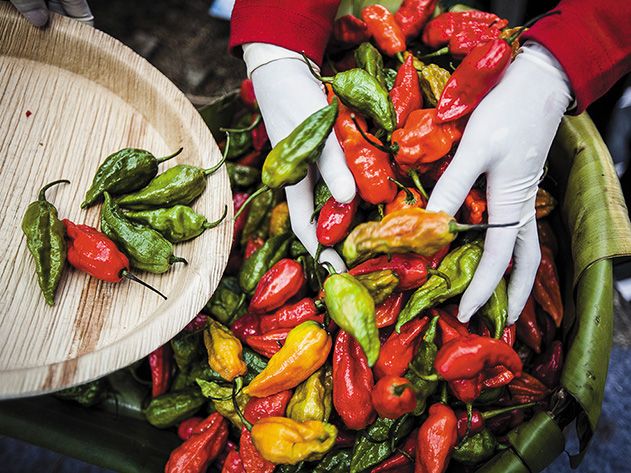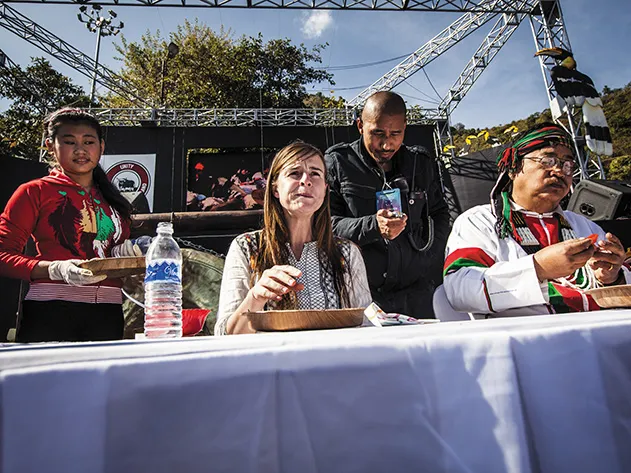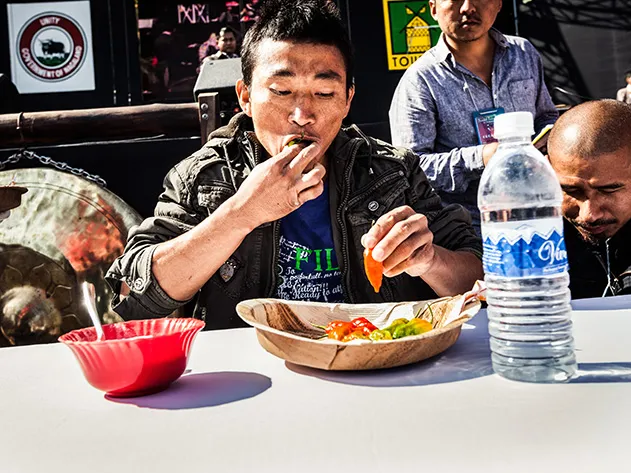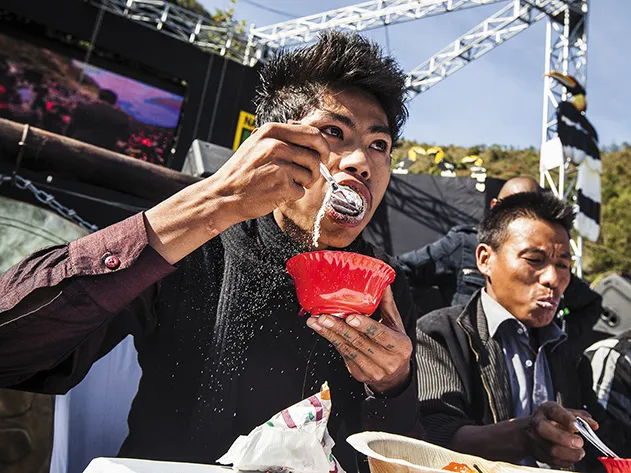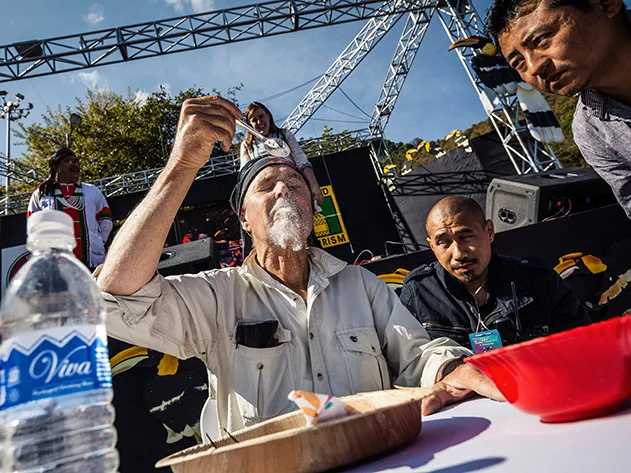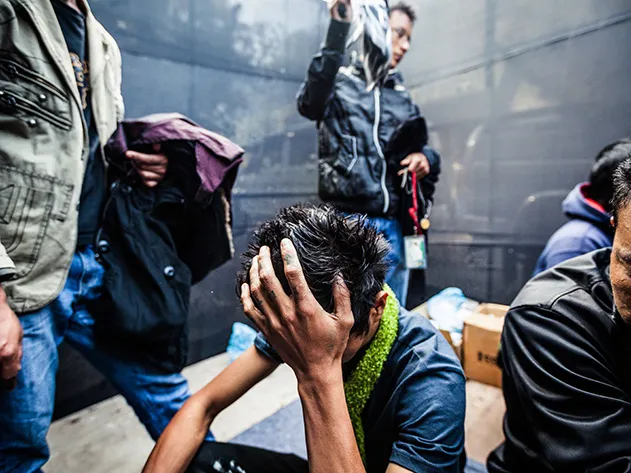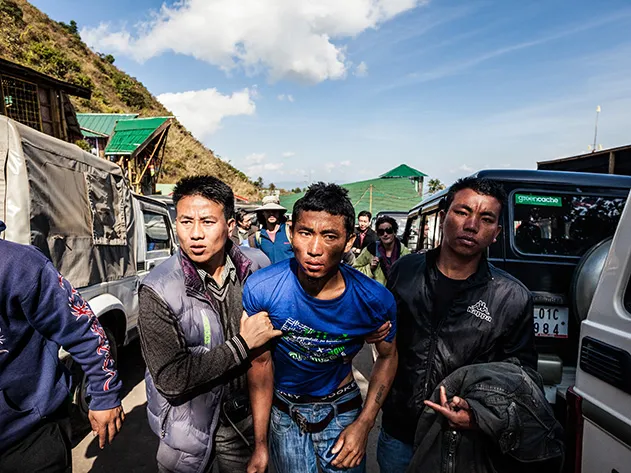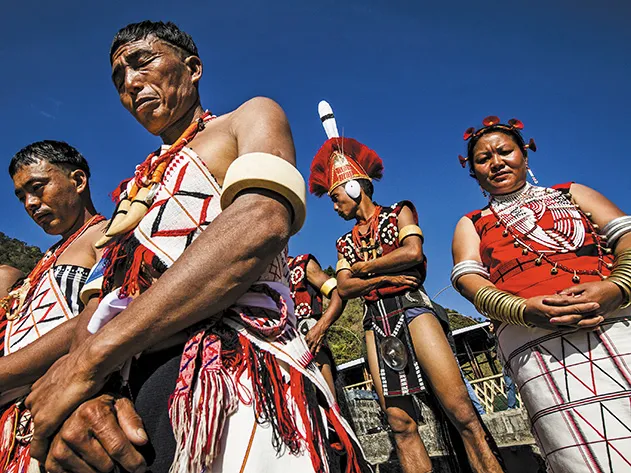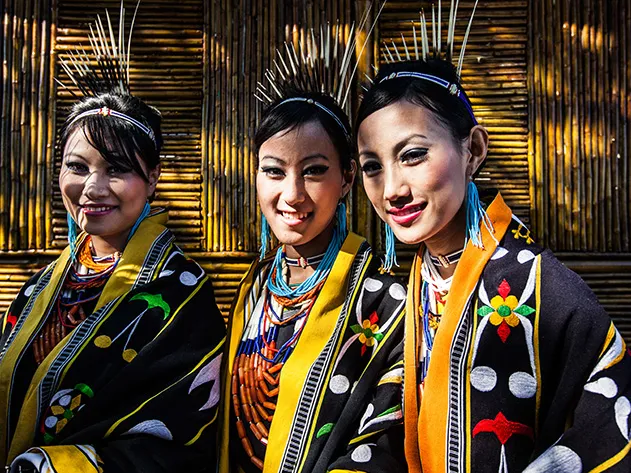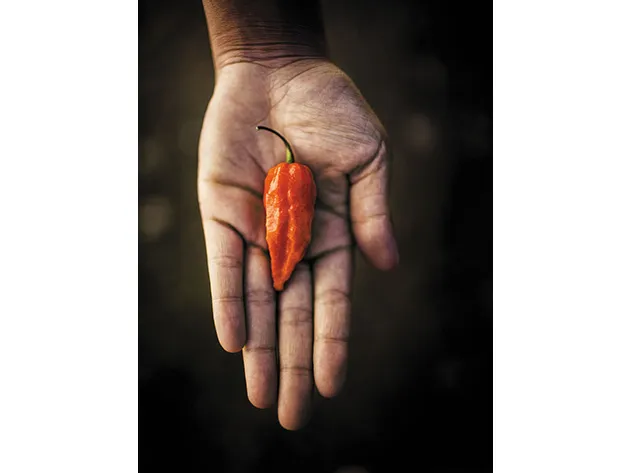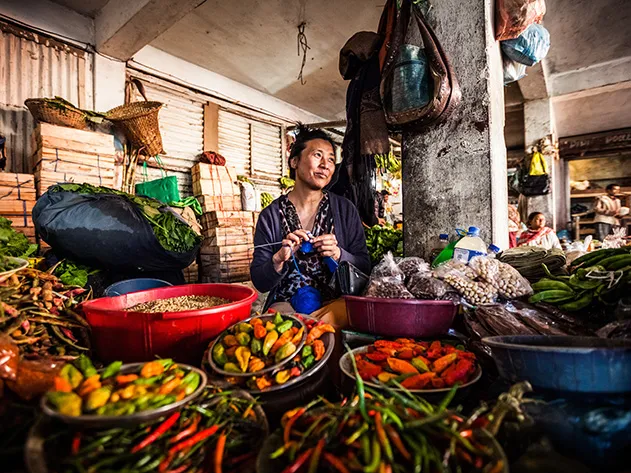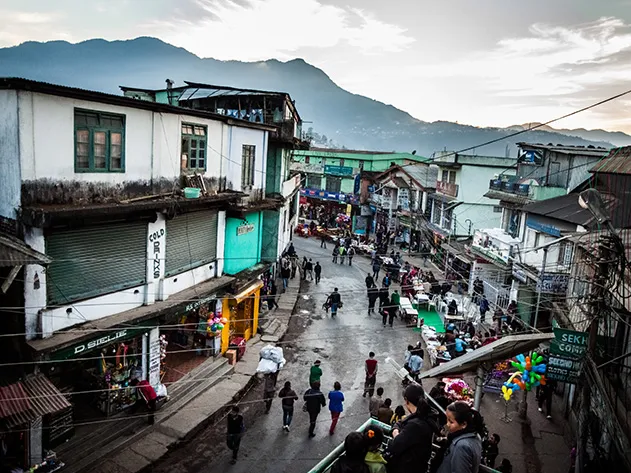The Gut-Wrenching Science Behind the World’s Hottest Peppers
Chiliheads crave the heat that hurts so good, but nothing compares to the legendary superhot that spices life in remote India
/https://tf-cmsv2-smithsonianmag-media.s3.amazonaws.com/filer/Burning-Desire-peppers-631.jpg)
The 17 tribes of Nagaland are united, historically, by an enthusiasm for heads. The Nagas: Hill Peoples of Northeast India—my reading matter on the two-hour drive from Dimapur to Kohima, in the state of Nagaland —contains dozens of references to head-taking but only one mention of the item that has brought me here: the Naga King Chili (a.k.a. Bhut Jolokia), often ranked the world’s hottest. “In the Chang village of Hakchang,” the anthropologist J. H. Hutton is quoted as saying in 1922, “...women whose blood relations on the male side have taken a head may cook the head, with chilies, to get the flesh off.” Hutton’s use of “cook” would seem to be a reference to Chang culinary practice. Only on rereading did I realize the Chang weren’t eating the chilies—or the flesh, for that matter—but using them to clean the skull.
Such is the perplexing contradiction of the genus Capsicum: condiment and industrial solvent, pleasure and pain. I’ve come to Nagaland to confront the conundrum on its home turf at the annual all-tribe get-together, the Hornbill Festival, which includes a Naga King Chili-Eating Competition.
The last known head-taking raid occurred sometime in the last century. (The verb “taking” is preferred over hunting. You do not hunt heads. You hunt people and then take their heads.) Most Nagas are Baptists now. Nonetheless, they appear to have pride in their gruesome heritage. A crossbeam on the front of the Chang exhibit building on the festival grounds is decorated with a row of cephalic bas-reliefs; lest anyone mistake them for family portraiture, the neck stalks drip red.
Men in loincloths stand outside on a break from rehearsing a warrior dance. I hold out a Bhut Jolokia I’ve been carrying in my jacket like a concealed weapon. I want to see who’s tough enough. Only one man steps closer. He points to the chili and uses an English word all Chang men know. “One of the enemy!”
It’s a sensible assessment. The chili pepper does not want to be your friend. It wants to hurt you so badly you turn it loose. Plants cannot bare teeth or run for the hills; they must protect themselves passively. Some are horribly bitter. Others, less forgiving, are poisonous. Capsaicin, the primary active ingredient in hot peppers, falls into the category of irritant, but that’s an insult to its power. (Chemical irritation, or chemical feel, is the third of the chemical senses, along with smell and taste.) Capsaicin in the eyes or airways is disabling to the extent that it is used as a nonlethal weapon—pepper spray. Bhut Jolokia grenades were developed several years ago by India’s Defence Research and Development Organization and used on protesters in Kashmir. (The grenades were shelved because the chili powder is prone to fungal rot.) Both the eyes and the airways are extremely sensitive, far more so than the skin or tongue. This is normally—outside of protests and riots—a good thing, because seeing and breathing are crucial to survival; the sensitivity of these organs and tissues motivates their owner to keep them safe.
Less immediate but no less excruciating are the effects on the digestive tract. As I’m about to see.
***
The Naga “national anthem” is a long song with an unusually vigorous horn section, or perhaps it only seems so to those of us seated in the bleachers right next to a two-story bank of speakers. Today’s Hornbill Festival program begins with a unity dance, in which each tribe showcases its unique cultural heritage and way of being loud. Old-timey muskets are fired. Drums galore. Someone wheels out a gong. The Chang’s warrior dance is accompanied by a maniacal whinnying cry that, even without amplification, can be heard all the way to the parking lot. “Ladies and gentleman, the Naga Pipers!” Somebody, somewhere in Nagaland history, for some reason, presented one of the tribes with bagpipes, and apparently it stuck. I gather what’s left of my hearing and flee.
I wind up behind the main stage just as the chili-eating competition is announced—an hour earlier than scheduled. While contestants take their seats onstage, an emcee recites rules. Competitors have 20 seconds to eat as many chilies as they can. Peppers must be chewed at least three times, to ensure the release of the pain-causing ingredient; the highest concentration of capsaicin is in the lining of the pepper—its placenta—and the seeds. (The chili plant, like any good mother, is protective of its offspring.)
Most of the dozen or so contestants are local residents: Nagas sufficiently tough or needy to endure the agony for a chance at the prize. (First place is $600.) Four are tourists: an Australian man, a man and a woman from Liverpool, and, inexplicably, Pu Zozam, a member of Parliament from neighboring Myanmar. Six teenage helpers in red and green Christmas dresses (it’s December) hand out bottles of water and bowls of Nestlé powdered “dairy whitener.” There is a school of thought that dairy products soothe the burn. It is true that capsaicin dissolves better in oil than in water, and milk (as well as powdered ersatz milk) has lots of fat. They will need whatever help it provides. In various tests carried out at the Indian Defence Research Laboratory and at New Mexico State University’s Chile Pepper Institute, the Bhut Jolokia has ranged from 500,000 to 1.5 million Scoville heat units (SHU). A chili that scores in excess of one million SHU qualifies as a “superhot.” By way of comparison, a jalapeño is around 4,000 SHU. (The Scoville number refers to how much dilution would be needed to render the heat imperceptible.)
“Ladies and gentlemen, your time starts now!”
The event itself is surprisingly low-key. The mood is one of stoic grimness. No one is screaming in pain. No one will be scarred by the heat. That’s not how capsaicin works. It only feels hot. The human tongue has pain receptors that respond to a certain intensity of temperature or acid. These nerve fibers send a signal to the brain, which it forwards to your conscious self in the form of a burning sensation. Capsaicin lowers the threshold at which this happens. It registers “hot” at room temperature. “It trips the alarm,” says Bruce Bryant, a senior researcher at the Monell Chemical Senses Center in Philadelphia. “It says, ‘Get this out of your mouth right now!’” The chili pepper tricks you into setting it free.
The whole affair is beginning to seem like an anticlimax when I look up from my notes to see Pu Zozam headed my way. I have seen people stagger in movies, but never for real directly in my sightline. Zozam’s legs buckle as he tries to keep walking. He goes down onto one knee and collapses sideways onto the floor. He rolls onto his back, arms splayed and palms up. He’s making sounds that are hard to transcribe. Mostly vowels. After a minute he rolls back onto his side and raises his head to retch. A doctor prepares a hypodermic of dicyclomine. The drug is more typically administered to people with irritable bowel syndrome, to relieve cramping. Cramps and regurgitation are body responses to gastrointestinal irritation. (This is why people throw up when they drink too much, too fast; alcohol is an irritant.) “The cramp is quite severe,” Catherine Burns, the contestant from Liverpool, told me later. She recalls sitting cross-legged with her fellow contestants afterward. Not good enough, her body informed her. “I suddenly just had to recline.”
Someone has unbuttoned Zozam’s waistband and shirt. Cold water bottles are pressed to his bare mounded belly. Others are cracked open and emptied over his head and his feet, now bare as well. Capsaicin is vasoactive. It opens up the peripheral circulation, dilating vessels in the skin and creating the sensation of being flushed. Pu Zozam is having the mother of all hot flashes. This is one reason capsaicin is used topically, for muscle pain. It’s a natural heating pad.
Zozam managed five chilies. The winner, Namlui Rongmei, finished 14. He’s crouched on the floor, glassy-eyed. I see him reach for the hem of the doctor’s white coat. A man behind me squats in the shrubbery, checking his smartphone while he waits for the vomiting to commence. He has been through this before. Incredibly, many contestants are repeat customers. Rongmei was last year’s runner-up. Surely there’s a better way to pay the rent. To quote a billboard just outside town, “Take up bee farming.”
Out in the arena, beyond the stage, the festival has moved on. The squeals of a greased pig contest provide soprano counterpart for the low tones of digestive torment. Backstage, the carnage has reached a peak. A paisley of curled up, writhing youth covers the floor. The drinking water cheerfully dispensed a half-hour ago is coming back up. The Christmas elves are abandoning their posts. From the far corner, Aaron, the photographer on the story, yells without taking his gaze from the lens. “Mary! Is my camera bag on high ground?”
In the tradition of the post-game interview, a chat with the winner seems to be in order. He’s now lying against a wall in the fetal position, his head supported by the caved-in cardboard Nestlé’s box. He speaks little English, but manages to convey his state: “Very no.”
***
Catherine Burns ate five Naga King Chilies, like Pu Zozam. Yet Zozam was taken away in an ambulance. I ran into Burns shopping for souvenirs 20 minutes after the competition. A vegan, she said that the most difficult part, for her, was the milk powder.
What accounts for the seemingly vast range in people’s tolerance for capsaicin? Some of it, of course, is genetics. Just as the number and density of taste receptors varies from tongue to tongue, so does the pain receptor count. (But not in a correlative way; so-called supertasters are not necessarily more sensitive to capsaicin.) According to Bryant, tolerance is more built than born. Just as bagpipes and muskets may damage auditory nerves, capsaicin gradually destroys the pain receptors that respond to it. Bryant gives the example of Mexican children introduced to capsaicin as young as 4 or 5, in the form of chili candies. By the time they’re adults, their receptor load has been devastated. “What would scorch your palate off is a pleasant burn to them.”
Burns regularly eats hot Thai, Indian and Mexican food. That she had sought out a Fireball Chili to try while visiting the nearby state of Sikkim suggests “chilihead” proclivities. Which raises the question: Are there people for whom searing oral pain is a positive experience, or are chiliheads simply people who’ve destroyed so many pain receptors that a superhot, to them, is like a jalapeño to you and me? There is also, Bryant points out, huge variability to what one defines as pain. “And then there’s the macho aspect,” he says, such as denying the pain to impress your dinner companions: “I don’t know how many people eat hot peppers in isolation.”
Food science has a theory called “dynamic contrast.” It holds that the human tongue likes variety and surprise. It likes a little salt with its sweet, a little crunchy with its creamy. Though technically an irritant, chili adds spice, literally and otherwise. Psychologists have other ideas on the topic. Some have explained the chili pepper’s popularity by way of the “risk-taking personality”: superhots as the edible version of sky diving. As a thrill seeker and a hot sauce fan, I’ve been looking forward to sampling the bhut.
***
The best Bhut Jolokia in the area are said to come from Zhadima, a village a half-hour outside Kohima on a gutted dirt road. The peppers grow on an untilled hillside amid a scramble of other greenery. The farmer who shows me around is a member of the Angami tribe. He smokes a hand-rolled cigarette and carries a machete that resembles a scaled-down dao—the traditional Naga implement of head-taking (and, in calmer moments, men’s haircuts). I tell him I want to try a freshly picked Bhut Jolokia, and he wraps a half dozen in a banana leaf for me. Walking back from the field, he leans down to pick a large three-sided pod with sharply serrated ridges. In Nagaland, even the peas look like they can hurt you.
I present the peppers to our host in Zhadima, a soccer coach named Roko. One I set aside to try. Roko takes me inside his mother’s cookhouse, sets the pepper on a wood counter and slices a sliver barely bigger than a cooked grain of rice. He ladles a cup of drinking water from a crock, salts the chili to reduce the heat and then steps back.
The Bhut Jolokia is unlike any pepper I’ve experienced, but the shock has nothing to do with the heat, which is easily bearable at so low a dose. It’s the flavors—a gorgeous vibrating chord of lemon, cut grass and florals. Roko cut it small because he wanted me to be able to appreciate it. With peppers this hot, the flavors get trampled by the pain. And that would be a shame.
Earlier this year, the Chile Pepper Institute measured the Scoville heat units of a variety of superhot peppers. Since growing conditions—soil, rainfall, temperature—play a part in the fruit’s heat as well as its lineage, all were grown in a plot on the institute grounds. The Trinidad Scorpion took first place, surpassing the Bhut Jolokia by as much as a million SHUs. Maybe I’m biased, but I can’t help thinking: Had the Bhut Jolokia been grown in Zhadima rather than New Mexico, might its fruit have been hotter? Perhaps the dry New Mexico climate conferred an advantage to the Scorpion and a handicap to the Bhut Jolokia. Even in Assam, the state adjacent to Nagaland, you can plant Bhut Jolokia seeds and wind up with a pepper mild enough that you can, as the director of the defense lab there said, “take it as a vegetable.”
That’s the pepper I’d want to import. Because, really, other than the chiliheads and the specialty food companies that cater to them, who wants a superhot chili? Who cares which one’s hottest? “Once you hit 1 or 1.5 million Scoville heat units,” allows Danise Coon, a researcher at the Chile Pepper Institute, “it all feels the same.” Bryant agrees. “For most people, that’s a saturating pain.”
Roko talks about a curry he plans to make with a pheasant shot the night before and four or five king chilis. With his knife, he points to the remainder of the pepper on the counter. “We Nagas, if we don’t eat this one, we aren’t satisfied.” And now I understand.
Planning Your Next Trip?
Explore great travel deals
Smithsonian magazine participates in affiliate link advertising programs. If you purchase an item through these links, we receive a commission.
